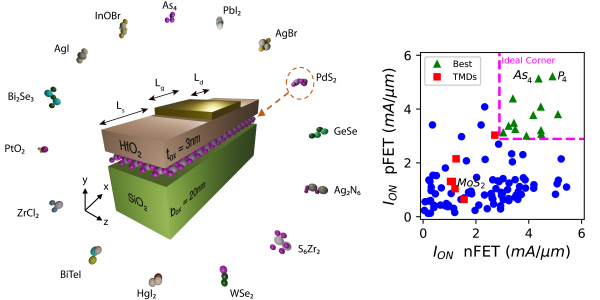2-D materials for ultrascaled field-effect transistors: One hundred candidates under the ab initio microscope
by Carey Sargent, NCCR MARVEL, EPFL
The functionality of electronic devices has been growing for more than five decades straight thanks to the continued miniaturization of transistors—the relevant areas of the silicon Finfield-effect transistors (FinFETs) now being produced are no more than a couple of nanometers in any direction.
While this miniaturization is driving performance, manufacturing them is extremely difficult and gives rise to strong quantum mechanical effects such as inter/intra-band tunneling that might negatively impact their switching performance. Resulting ultrashort gate lengths also mean that maintaining good electrostatic properties has become difficult, even with multigate architectures. Researchers have therefore been exploring different options to extend Moore’s scaling law (More-Moore) or go beyond it (More-than-Moore). The remarkable properties of single-layer 2-D materials suggest that they could be excellent candidates for doing this.
A CSCS article on the paper evaluating potential candidates using ab initio simulations can be found here.

References: Klinkert C, Szabo A, Stieger C, Campi D, Marzari N & Luisier M: 2-D Materials for Ultra-Scaled Field-Effect Transistors: Hundred Candidates under the Ab Initio Microscope, ACS Nano (2020), DOI: 10.1021/acsnano.0c02983
Low-volume newsletters, targeted to the scientific and industrial communities.
Subscribe to our newsletter